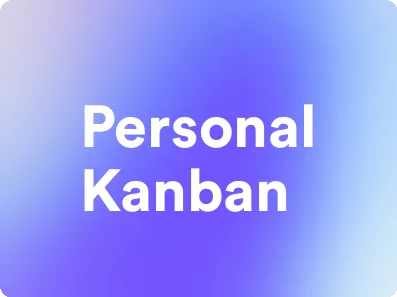Personal Kanban: A Productivity Tool for Effective Task Management
This guide will walk you through the essential elements of using personal kanban - the productivity method to keep your team productive and engaged.
Try Lark for Free
In today's fast-paced and dynamic work environments, individuals often find themselves juggling multiple tasks and struggling to maintain an organized workflow. Personal kanban offers a structured and visual approach to managing tasks, enabling individuals to enhance their productivity and achieve better control over their workloads. In this comprehensive guide, we will delve into the concept of personal kanban, its origins, suitability for different individuals, pros and cons, and provide practical steps to get started, along with actionable tips and do’s and dont’s to optimize its effectiveness. Furthermore, we will address frequently asked questions to deepen understanding and assist in its successful implementation.
What is Personal Kanban?
Personal kanban is a personal productivity system that emphasizes the visualization of work and the limitation of work in progress. By utilizing visual boards and specific columns, individuals can gain a clear overview of their tasks, prioritize effectively, and track progress. The primary goal is to provide a visual representation of ongoing work, making it easier to identify bottlenecks and manage tasks efficiently.
LSI and NLP Keywords: task management, visual management, time management, productivity tool, agile tool, efficiency, workflow visualization, lean principles
The Origin of Personal Kanban
The concept of kanban originated in the context of lean manufacturing, specifically as part of the Toyota Production System. It was initially used as a scheduling system to regulate the flow of work in production lines. Over time, kanban principles were adapted and evolved into personal productivity systems, with notable contributions from individuals such as David J. Anderson and Jim Benson. These adaptations made the principles of visualization and limiting work in progress accessible to individuals outside of a manufacturing context, allowing for broader applications in personal and professional productivity.
LSI and NLP Keywords: lean manufacturing, Toyota Production System, Taiichi Ohno, David J. Anderson, Jim Benson, Lean Coffee, agile methodologies
Use Lark to unleash your team productivity.
Who Is Personal Kanban For?
Personal kanban is a versatile productivity tool suitable for a wide range of professions and industries. Knowledge workers, freelancers, project managers, students, creatives, remote workers, as well as self-employed individuals and entrepreneurs can all benefit from implementing personal kanban. Its adaptability is evident in the various ways it can be tailored to align with the needs and preferences of different individuals and work scenarios.
LSI and NLP Keywords: freelancers, knowledge workers, project managers, students, creatives, remote workers, professionals, self-employed, entrepreneurs
Pros and Cons of Personal Kanban
Advantages
- Provides a clear visualization of tasks and their progress, promoting better understanding and control over workloads.
- Enables the effective prioritization of tasks, ensuring that the most critical activities receive appropriate attention.
- Facilitates improved time management and workflow optimization, contributing to enhanced productivity.
Limitations
- May require initial adaptation and adjustment to establish an effective personal kanban system.
- Can potentially become overwhelming if not managed effectively, especially for individuals with highly dynamic workloads.
- The digital implementation of personal kanban may involve a learning curve for individuals less familiar with digital productivity tools.
LSI and NLP Keywords: advantages, benefits, drawbacks, limitations, comparisons, task tracking, agile boards, project visualization
Learn more about Lark x Productivity
How to Get Started with Personal Kanban
To begin implementing personal kanban, individuals can follow these essential steps:
1. Setting Up a Personal Kanban Board
Utilize a physical board or a digital platform, such as Trello or Asana, to create your personal kanban board. The board should ideally consist of columns representing "To Do," "Doing," and "Done."
2. Establishing Workflow Stages and Visualization Techniques
Identify the stages of your typical workflow and map them onto the columns of your personal kanban board. Utilize visualization techniques such as color-coded sticky notes to categorize different types of tasks.
3. Integrating Digital and Physical Tools for Personal Kanban
Consider integrating digital tools for a more dynamic and accessible personal kanban experience. Experiment with different software applications to identify the most suitable option for your specific preferences and requirements.
LSI and NLP Keywords: creating a kanban board, workflow optimization, digital tools, physical tools, sticky notes, Trello, JIRA, Asana, KanbanFlow
Use Lark to unleash your team productivity.
Actionable Tips for Personal Kanban
Effectively utilizing personal kanban involves considering the following tips:
- Have a dedicated daily or weekly review routine to assess your progress and make necessary adjustments to your personal kanban board.
- Prioritize tasks based on both their urgency and their contribution to larger goals or projects, ensuring that focus remains aligned with overarching objectives.
- Experiment with different visualization and column categorization techniques to identify the most suitable approach for your unique workflow.
LSI and NLP Keywords: productivity tips, time-saving strategies, workflow optimization, routine integration, agile practices, task efficiency
Do's and Don'ts
Do's
- Visualize your tasks to promote clarity and understanding of your workload.
- Limit work in progress to ensure focus and prevent overload.
- Regularly update your personal kanban board to maintain accuracy and relevance.
Don'ts
- Overload your work in progress, as this may lead to decreased efficiency and increased stress.
- Neglect to update the personal kanban board, as outdated information can hinder effective task management.
Conclusion
Personal kanban, with its foundations in lean and agile principles, offers individuals a powerful approach to task management and workflow visualization. By leveraging the inherent visual nature of personal kanban, individuals can gain a deeper understanding of their workloads, prioritize effectively, and ultimately enhance their productivity. Embracing the principles and practices outlined in this guide can empower individuals to take control of their tasks and optimize their personal and professional endeavors.
Use Lark to unleash your team productivity.
